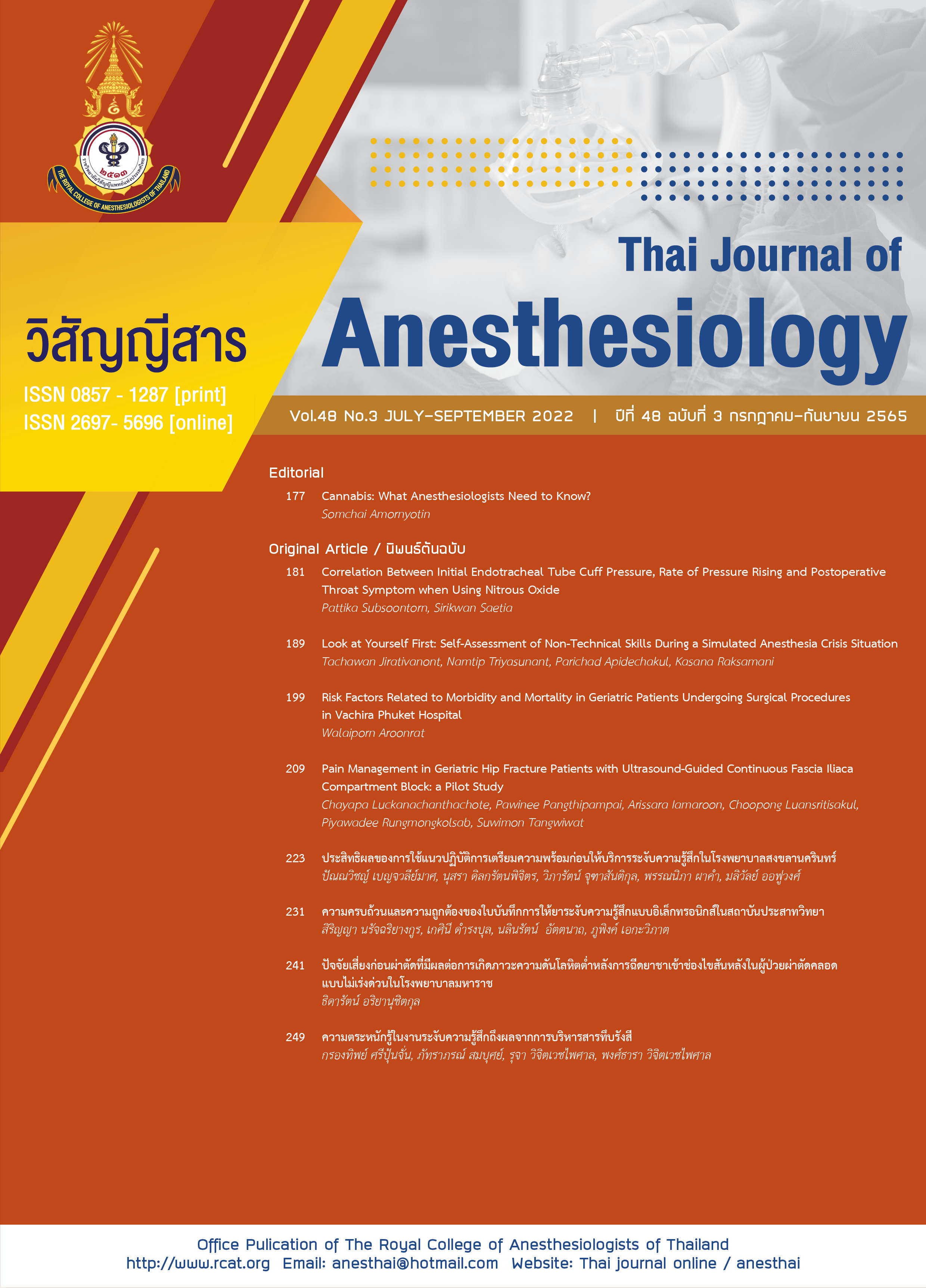Effectiveness of guideline preoperative induction checklist in Songklanagarind Hospital
Main Article Content
Abstract
Background: The preoperative induction checklist (I AM SAM) to be the part of the patient safety hospital has been developed at our anesthesiology department. Objectives: The research team investigated the anesthesia related adverse events after using I AM SAM checklist. Methods: This prospective observational study including patients who received anesthesia from January 2019-July 2020. The anesthesia team (anesthesiologist/nurse anesthetist) performed I AM SAM checklist before, during and after induction of anesthesia as well as recorded information regarding adverse events in the record form until completing the surgery. The descriptive statistics were described by frequency and percentage Results: A total of 1,855 patients were recruited. The completion of the checklist was almost 100% of each item. After using I AM SAM checklist, the incidence of intravenous leakage was found the most (0.92%), the second most incidence was medication error (0.49%), the third most incidence was equipment failure (0.27%), and incidence of cardiac arrest and hypoxemia were 0.22%. No incidence of failed intubation, Transfusion mismatch and wrong patient wrong site were found in this study. Conclusions: The completion of the checklist I AM SAM was almost 100% of each item. The two most incidence found after using I AM SAM checklist were intravenous leakage and medication error, respectively.
Article Details

This work is licensed under a Creative Commons Attribution-NonCommercial-NoDerivatives 4.0 International License.
References
เพ็ญจันทร์ แสนสบาย. การจัดการทางการพยาบาลเพื่อความปลอดภัย.กรุงเทพฯ: สุขุมวิทการพิมพ์จำกัด; 2551.
สุภัทราพงษ์ พิลาดิษฐ์. การบริหารความเสี่ยงเพื่อป้องกันการผ่าตัดผิดคนผิดอวัยวะผิดตำแหน่งของห้องผ่าตัด
โรงพยาบาลบึงกาฬ. วารสารเครือข่ายวิทยาลัยพยาบาลและสาธารณสุขภาคใต้. 2558; 66-84.
นันธิดา พันธุศาสตร์, ราตรี ทองยู. แนวปฏิบัติการพยาบาลตามมาตรฐานความปลอดภัยของผู้ป่วย.วารสารพยาบาลสภากาชาดไทย. 2560;1-13.
อนุวัฒน์ ศุภชุติกุล. Patient safety goals: SIMPLE. นนทบุรี: สถาบันพัฒนาและรับรองคุณภาพโรงพยาบาล; 2551.
Weiser TG, Regenbogen SE, Thompson KD, et al. An estimation of the global volume of surgery: a modelling strategy based on available data. Lancet. 2008;372:139-44.
Earnshaw JJ, Alderson D. Sustainable global surgery. Br J Surg. 2014;101:1-2.
Wang Y, Eldridge N, Metersky ML, et al. National trends in patient safety for four common conditions, 2005-2011. N Engl J Med. 2014;370:341-51.
Hintong T, Chau-in W, Thienthong S, Nakcharoenwaree S. An analysis of the drug error problem in the Thai Anesthesia Incidents Study (THAI Study). J Med Assoc Thai. 2005;88(Suppl7):S118-27.
Rosner B. Fundamentals of biostatistics. 5th ed. Duxbery: Thomson learning; 2000.
World Health Organization. Safe surgery saves lives: the second global patient safety challenge 2012.
Albarrak AI, Al Rashidi EA, Fatani RK, Al Ageel SI, Mohammed R. Assessment of legibility and completeness of handwritten and electronic prescriptions. Saudi Pharm J. 2014;22:522-7.
Agrawal A. Medication errors: prevention using information technology systems. Br J Clin Pharmacol. 2009;67:681-6.
จันทร์ฉาย แสงแก้ว, พลพันธ์ บุญมาก, สุหัทยา บุญมาก, กฤษณา สำเร็จ, เพ็ญวิสา แนวทอง, สุพัฒตรา ศรีพอ. การสำรวจปัญหาการตรวจสอบเครื่องวางยาสลบประจำวันในโรงพยาบาลศรีนครินทร์. ศรีนครินทร์เวชสาร. 2548;20:222-8.
Chanchayanon T, Suraseranivongse S, Chau-in W. The Thai Anesthesia Incidents Study (THAI Study) of difficult intubations: a qualitative analysis. J Med Assoc Thai. 2005;88(Suppl7):S62-8.


